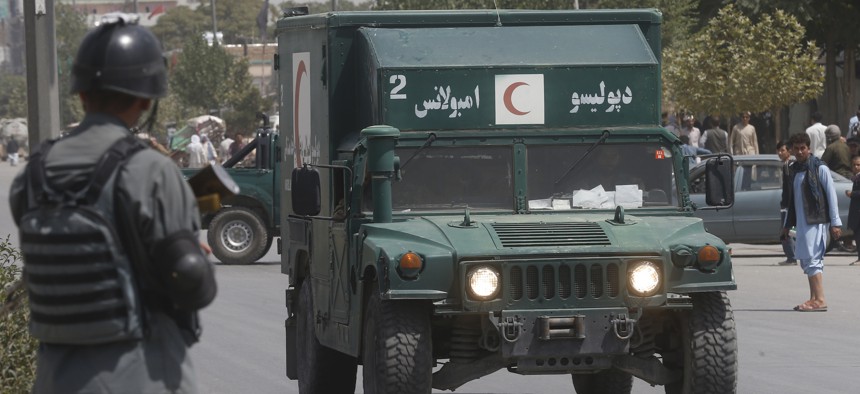
An Afghan military ambulance rushes towards the site of an explosion that wounded dozens of people in Kabul, Afghanistan, on Aug. 7, 2019. The Taliban claimed responsibility for the attack. AP Photo/Rafiq Maqbool
Can US-Taliban Peace Talks End the War in Afghanistan?
U.S. officials say that they are close to reaching a deal with the Taliban, but peace in the country would still not be guaranteed.
This year has seen the most intensive diplomacy yet between the United States and the Taliban to end the nearly eighteen-year war in Afghanistan. But disagreement over the conditions of a peace deal, coupled with the Afghan government’s ambiguous role in the talks, calls into question the feasibility of lasting peace.
What’s the latest?
U.S. officials, led by envoy Zalmay Khalilzad, have met with Taliban leaders in eight rounds. The negotiations have gathered momentum over the past few months, in part driven by pressure from Washington to reach a deal by September 1. The parties produced a draft agreement in March and have since inched closer to finalizing its terms.
Separately, the Taliban has met with Afghan leaders since 2017, though only unofficially, because the Taliban views the Afghan government as an illegitimate “puppet regime” of the West. These meetings, especially the recent “intra-Afghan dialogue,” are a positive step, experts say, but still far from the formal negotiations needed for a peace deal.
Related: Don’t Peg Troop Withdrawals to the Political Calendar
Related: Escalating the US Air War in Afghanistan Isn’t Working
Related: It’s Getting Harder to Track US Progress in Afghanistan
Meanwhile, China, Pakistan, Russia, and the United States have held related meetings on the peace process.
What do the Taliban and the United States want?
The negotiations appear to be focused on four elements:
- Withdrawal of foreign forces. Both sides agree on the full withdrawal of the fourteen thousand U.S. troops currently in Afghanistan, as well as of additional foreign forces, but they disagree on the timeline. The United States is reportedly offering a two-and-a-half-year deadline, while the Taliban insists on nine months.
- Counterterrorism assurances. The Taliban has agreed to prevent Afghanistan from being used by terrorist groups, but negotiators disagree over how to define the terms “terrorism” and “terrorist.”
- Intra-Afghan dialogue. Washington has urged Afghan government and Taliban leaders to begin official talks on how Afghanistan will be governed after the war, but the Taliban refuses to negotiate with the government until after it has reached a deal with the United States.
- Comprehensive cease-fire. U.S. negotiators seek a permanent cease-fire among U.S., Taliban, and Afghan government forces prior to a peace deal, but the Taliban insists on putting off a cease-fire until U.S. troops have withdrawn.
The protection of women’s rights is also one of the United States’ implicit demands, though it is not officially expressed in the draft agreement. Taliban negotiators have acknowledged women’s rights but said that they must be consistent with Islamic principles.
What’s at stake?
Many worry that a failed peace deal will exacerbate fighting and increase the civilian death toll, especially since the Taliban has carried out attacks throughout the negotiations and vowed to target civilian participants in the upcoming presidential election. Over the past five years, more than 45,000 Afghan troops and police officers were killed. A UN report [PDF] found that in the first six months of this year, 3,812 civilians were killed or injured, including 1,207 children. Continued war could also exacerbate the production of illegal drugs and drive more Afghans to seek refuge abroad.
Since the war began in 2001, more than 2,400 Americans have been killed and some 20,000 injured. More than 1,100 NATO troops have also been killed. The war has cost the United States a total of $975 billion [PDF]. On top of that, medical care and disability payments for veterans will cost an estimated $1 trillionover the next forty years.
What are the prospects for a peace deal?
Despite reassurances of progress by Khalilzad, many factors could cause the peace process to fall apart.
For one, it is uncertain whether the Afghan government, largely sidelined from the peace process, will recognize and abide by a U.S.-Taliban deal. The Taliban could also walk away from the negotiating table, believing that it can push U.S. troops to withdraw without a deal.
“The biggest deal-breaker may be an inability of the Taliban negotiators to get all the factions of the Taliban to follow any peace document that is signed,” said Peter Galbraith, a former U.S. diplomat and UN official, in an interview with Al Jazeera.
Even if the United States and the Taliban reach an agreement, many fear that it will only end U.S. military involvement in Afghanistan and not conflict in the country at large. If Taliban and Afghan government leaders are unable to broker a power-sharing agreement, many experts say, Afghanistan will remain a hub of instability where its citizens fear attacks, and it could once again serve as a haven for al-Qaeda and terrorist groups affiliated with the self-proclaimed Islamic State.
This piece, first published by the Council on Foreign Relations, is used with permission.



